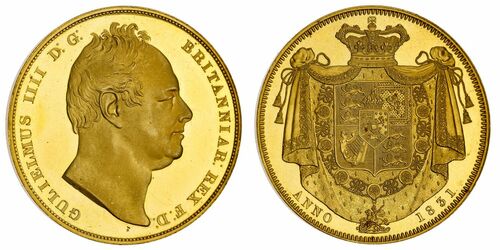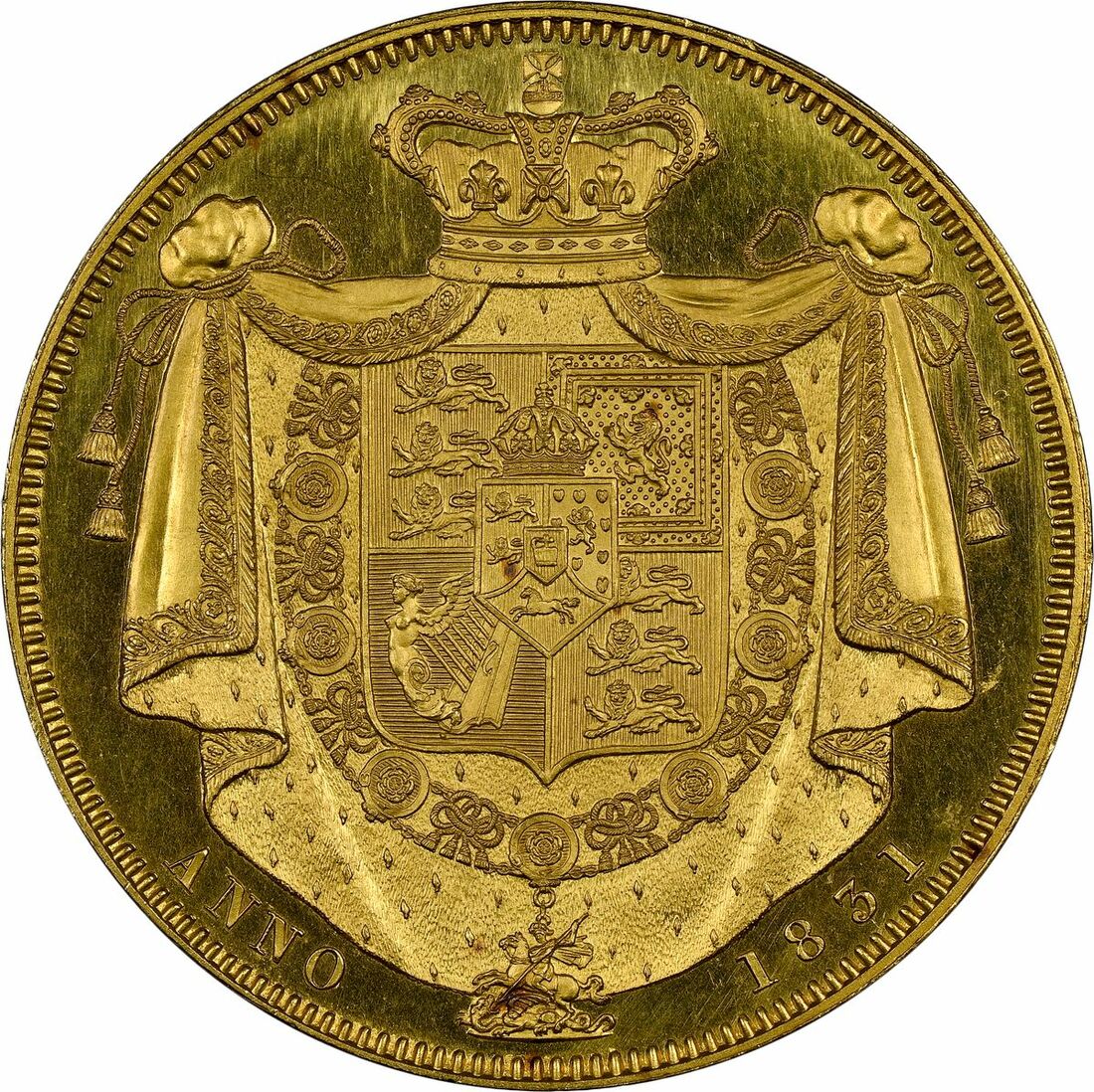Auction: 23151 - The St Helier Collection of English Gold Coins - Part II
Lot: 2006
(g) NGC PF63+ UCAM | William IV (1830-1837), Pattern Proof Five-Pounds, 1831, struck from the Coronation 'W.W.' Crown dies in .999 Fine Gold, by William Wyon after Francis Chantrey and Jean-Baptiste Merlen for the Royal Mint, GULIELMUS IIII D: G: BRITANNIAR: REX F: D: bare head right, W.W. buried in truncation, rev. crowned shield-of-arms within the Collar of the Order of the Garter and draped with ermine mantle, St George pendant below, edge plain, [Median Spink XRF: 99.99% Au], 39.828g [614.64grns], 5h ("A Memoir of the Life and Works of William Wyon ESQ A.R.A, Chief Engraver of the Royal Mint", Nicholas Carlisle [1837], pp. 107-109; "The Wyons", L S Forrer [Spink, 1917], p. 103; KM Pn99; Fb. 381; PCGS ID 531509/542036; MCE p. 94, Pattern 34a; L&S 2, p. 71 this coin mentioned; Davies 300; W&R 270 [R5]; ESC 272 [R5]; Bull 2463 [R5]; Holloway GH 102; Sainthill -; Montagu 1086; Murdoch 437; Nobleman 198; Wertheimer 176 = Lingford 533; Blake BL310 this coin ['6 known']; Lady Duveen 64 = Douglas-Morris 184 ['about 10 known']; Spink 3833), an historic scratch to forehead with the faintest wisps to fields, below neckline and to right of mantle above the expected die flaw, with delicate carbon spotting to peripheries, otherwise entirely original and utterly splendiferous, the "frabjous" fields of Wyon's auriferous "wonderland" canon a befittingly exalted canvas for the strikingly high relief and stupendously cameo "Coronation portrait" personally approved by the King from this very obverse die, from an exceedingly limited corpus; this the viable finest of the nine confirmed specimens; truly "fresh from the die" and technically FDC, totally unblemished by recent 'conservation' or even rim contact marks that plague the extremities of every other known survivor, simply put: outrageous; extraordinary; and practically peerless; unseen at public auction for almost a CENTURY, having previously blessed the Alfred John Morris; George Hamilton-Smith; Hugh Vincent Summers, George Blake and Charles Dabney-Thompson cabinets, in NGC 'St. Helier' holder, conservatively graded PF63+ ULTRA CAMEO (Cert. #6767923-004) [Only 1 Certified Finer]
Provenance
~ Recorded in the Guinness Book of World Records (1969) as the most expensive British coin ever sold at the time. For context, the average house price in the United Kingdom in July 1966 was £3,558.0.0 ~
Spink, by private treaty, 4 July 1966 - £5,350.0.0
Charles Dabney-Thompson, collection purchased en bloc by Spink, 1965
SCMB, June 1956, BL310* - "AV Five Pounds, 1831, Pattern by William Wyon and Merlen...only six coins of this denomination are believed to have been issued. brilliant, FDC, RRRR" - £800.0.0
George Blake, collection purchased by Seaby, May 1956
~ 1956: "In May of this year we were able to announce the purchase of the George Blake collection, which was one of the best we have bought in recent years. Pieces worth noting where the Cromwell half-broad, Charles II Petition and Reddite crowns, the George III five guineas of 1777, and the William IV five pounds of 1831" (H A Seaby, SCMB, July 1966, p. 241) ~
B A Seaby, by private treaty with George Blake, by February 1947
Hugh Vincent Summers ['XYZ'], collection purchased by Seaby, 1946
George Hamilton-Smith (died 18 November 1926), Glendining, 23-25 May 1927, lot 189 - "Pattern Five Pound Piece, 1831....edge plain, brilliant and of great rarity" - £110.0.0 [Spink for H V Summers]
"Formerly in the Morris Collection"
Alfred John Morris (5 February 1880 - 16 January 1943), collection sold by private treaty to Hamilton-Smith, between April and July 1922
Little is known about the Morris collection, as only Hamilton-Smith seems to have directly or at least publicly benefitted from it. It contributed at least three coins, a 1770 Pattern Five Guineas, an 1820 Five Pounds and this 1831 Five Pounds which is rather telling of its calibre and quality. Indeed Morris, first appears on the radar at the Nobleman sale of 27 March 1922, when he newly-registers as a commission bidder with Spink for the sale. Presenting the profile of an investor, strangely Morris targets only four lots - the strikings in silver of the 1820 Five-Pounds and Two-Pounds; a Pattern 1816 Sovereign, and finally lot 67A - the Incorrupta Crown in Gold. Strikingly no effort was made towards bidding for the Pattern Five Guineas, the 1820 Five Pounds or indeed the Renotiere example of the 1831 Gold piece - highly suggestive of a pre-existing collection, but an especially targeted focus when bidding. In each case Morris would be defeated by Spink's separate commission bidder Virgil Michael Brand, perhaps initiating Morris to apply for membership to the British Numismatic Society only a month later whereupon he would undoubtedly have met one of its council members, George Hamilton-Smith who probably persuaded him to approach him in his separate capacity as newly acting director of auctioneer Glendining's. His father had founded a company of upholsterer spring manufacturers, having started his career as a book-keeper in Belper, Derbyshire. Partnering with Edward Bagshaw, the firm of Bagshaw and Morris operated under the Morris' sole ownership from 43 Charlotte Road, Shoreditch between 1889 and 1935. It claimed to be the oldest manufacturer of coppered-steel springs for the upholstery trade.
Corpus:
1) The Arnold Specimen (May 1993); Private Collection [PCGS PR63 DCAM]
2) The Murdoch Specimen (January 2020), 39.87g; Private Collection [PCGS PR63 DCAM - Cert. #39237162]
3) The Duveen Specimen (October 2020), 39.90g; Submitted for grading, Sarasota, Florida (January 2014), and 'brown'-holdered [NGC PF63 UCAM - Cert. #3731659-001]; Resubmitted and "conserved" before sale in Monaco; Private Collection [NGC PF66* UCAM - Cert. #5744153-004]
4) The St. Helier Specimen (May 1927), 39.828g, this coin; [NGC PF63+ UCAM - Cert. #6767923-004]
5) The Paramount Specimen (January 2023), 40.446g; graded NGC Proof Details ~ Obverse Tooled [Cert. #6066350-025]; Private Collection, presently unencapsulated.
6) The Thomas H Law Specimen (August 2013); [NGC PF63 UCAM].
7) The Strauss Specimen (May 1994); [PCGS PR61 DCAM]
8) The Hunterian Specimen (-), ex Major-General William Yorke-Moore, Sotheby's, 21 April 1879, lot 340 - £22.0.0 [Rollin & Feuardent for Burns]; Edward Burns, by private treaty with Coats; Thomas Coats, collection bequeathed to Hunterian Museum, 1921
9) The Ashmolean Specimen (-)
https://www.ngccoin.com/certlookup/6767923-004/63/
Subject to 20% VAT on Buyer’s Premium. For more information please view Terms and Conditions for Buyers.
Sold for
£370,000
Starting price
£200000

















